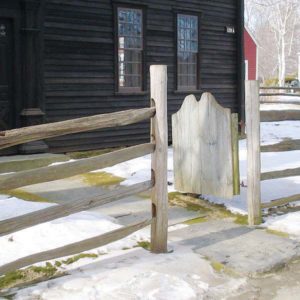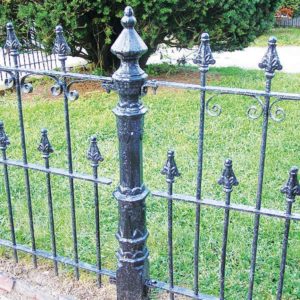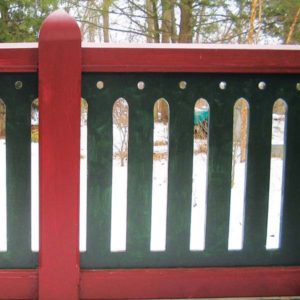For those of us enthralled with vintage and antique homes, our enthusiasm often extends to the entirety of the estate, which includes preserving any outbuildings as well as the grounds and landscaping.
And while there’s nothing wrong with religious statuary, it pains us to see a half-buried bathtub in front of a lovely Federal, unless it’s painted Prussian Blue and not Aqua. The same holds true for period-appropriate fences: their existence on any specific historic property either directly enhances or detracts from the historic impression of the structures. Granted, it’s not like the Fence Police are going to pull it down (except if you live on Beacon Hill), it’s more that given the multitude of options, why not put up an accurate fence, if one is needed at all?
Fences have always been a device to differentiate between “mine” and “yours”; in the first part of our nation’s history, their purpose was focused specifically on controlling livestock, but as the population density grew and we were forced to live in closer proximity, the fence became a way of marking the boundaries of our homestead, whether it was a tiny plot in front of a row-house or a suburban split-level whose animal inhabitants consisted of nothing larger than an occasional skunk pawing through the trashcans.
One of the earliest types of fence was the Paling Fence; these were constructed of vertically positioned branches or saplings with sharpened ends. As sawn lumber became more common, flat planks or boards replaced the rustic timbers and their tips were usually cut at a 45-degree angle. It’s a very short leap to see how the paling fence evolved into our picket and stockade fences of today.

Until the late 18th century, the other typical style of fence was the split- or log-rail fence. This type of construction continues to be omnipresent in rural areas up until and including the present day. A tip to owners of 18th century homes: should you elect to install one of these fences, Mr. Sensitive humbly requests that you avoid the “El Ranchero Grande” look of the mass-produced versions and seek out the more authentic, rusticated variety.
The humble picket fence blossomed into a woodworker’s tour de force during the Georgian, Federal and Greek Revival Periods, with the pickets becoming much more delicate and often lathe-turned or graced with a pyramidical finial. Their heights might be staggered low-high-low or arranged in undulating arcs. While some fences were still supported by simple, capped posts, more prominent homes proudly displayed massive piers that might emulate block construction or elaborate paneling and columns.
The Victorian era was a time of great mechanical innovation and experimentation with materials. One of the first new technologies of this period was the mass-production of cast iron. Suddenly, ornate metalwork could be created in bulk instead of the labor –intensive method of forging iron. As refinements in metallurgy occurred, and the fabricators improved their processes, they began to understand the strengths and limitations of cast iron. The technique of melting and casting proved unsuitable for some structural scenarios where stresses occurred that could shear or snap off sections. Wrought iron, conversely, possessed a far greater tensile strength, but required much more hand-work. Eventually, metal-workers began to combine the two types of ironwork for an optimal blend of beauty and strength, using the cast elements for decorative panels and wrought sections for structural members and mounts.
From Our Trusted Partners
Featured property

The metal fencing of the 19th century echoed the architectural styles it was designed to embellish. As the foundries multiplied during the height of the Gothic Revival, we see many a fence ornamented with qua-trefoils and tracery. As the French and Italian influences of the Rococo and Renaissance revivals waxed and waned, this also was reflected in the motifs found on metal fencing. The brief Egyptian Revival of the 1870s is highly represented by the flattened lotus motif found in front of so many Brooklyn brownstones.
Another innovation of the Victorian era was machinery that could produce continuous lengths of iron and steel wire or rods. Eventually, someone figured out that you could bend a length of iron rod into an elongated “U” shape that resembled a giant bobby-pin, and then affix these to horizontal iron rails, and thus, the Hairpin Fence was born. Immensely popular in both residential and commercial applications, it was inexpensive and sold in a variety of patterns aside from its basic form; there’s the hairpin and bow, the hairpin and iron picket and hairpins that overlap, creating a continuous row of intersecting semi-circles.

During the last quarter of the 19th century, wooden fences re-emerged as a popular material, spurred on in part by the Stick-style or Swiss Chalet style. Fanciful patterns were cut out from each adjacent picket to create a repeating motif in the voids where the boards butted together. This technique is also seen on porch lattice, and lasted through the Arts & Crafts period and into the early 20th century.
At the same time, the Colonial Revival drew its inspiration from the Georgian and Federal eras and replicated its fence styles, but usually in a smaller scale and with some restraint of ornamentation. This was also the time of the plain white picket fence that has become iconic, and seemed to grace every cottage and cape built between 1910 and World War II.
The most important factor in the preservation of any fence is pro-active maintenance. Moisture and severe extremes in temperature are insidious enemies that wreak havoc with all fences, wood or metal. Keeping things primed and painted, no matter how tedious it seems, will preserve a fence for decades if not a century. Clearing soil and debris from horizontal lower rails is also a necessity, as not doing this invites rot and decay that attacks a critical structural member who failure requires a dismantling of that section.
Dan Cooper is a well-known author, and has published over a thousand articles on the subjects of antiques, architecture, preservation and historic interior design. His first book, New Classic American Houses, was published by The Vendome Press. Dan is also President and CEO of Cooper Lace, has designed and sold historic lace curtains for twenty four years, providing them to private homes, museums and film sets. Dan is recognized as a leading authority on the subject of historic carpeting.



